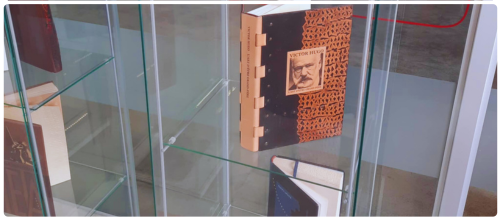You are warmly invited to “Nepavaldi laikui”, an exhibition of leather books hand-bound by artist and lecturer Lolita Grabauskienė from the Academy of Arts, Faculty of Arts and Education, Kauno kolegija Higher Education Institution, on display on the library’s second floor.
Annotation
_________Currently, several trends dominate the field of artistic bookbinding worldwide. The first trend focuses on professional craftsmanship, where the main attention is given to the quality of the craft and the traditions of artistic bookbinding. Another trend centers on the artist’s book, where the greatest emphasis is placed on the book’s content and illustrations. There are also book-objects, where the informational function of the book gives way to artistic form and emotional meaning. All these areas are unified by artistic, authorial bindings, which are largely presented in this exhibition.
_________Leather books were originally meant to protect information and ensure longevity. Only later did more attention begin to be paid to their aesthetic appearance. This led to the formation of bookbinders’ guilds and a distinct art form. When binding a leather book, it is essential to quickly familiarize oneself with its content and perceive it as an object of artistic creation, while also taking into account the author’s information, style, and historical context. In this way, a book can take on an unexpected form, becoming important as a symbol and a source of creative inspiration.
_________The book, as we know it today, underwent a long and complex transformation. Many historical bindings were forgotten for a long time, but today we see a renewed interest in old traditions, which are becoming sources of new ideas and opportunities for creative interpretation using modern materials and technologies.
_________This exhibition features classic hardcover books, whose creation process is long and intricate. However, there are also interpretations of historical bindings, such as long stitch binding on leather straps, secret Belgian binding known for its unique cover structure, one of the oldest techniques – Coptic binding – as well as interpretations of the concertina binding principle. Some bindings were created with minimal use of glue, meaning they can be easily disassembled and transformed.
_________Books have been very important to me since childhood. My first encounter during adolescence with a large-format original leather-bound book with metal clasps, similar to those displayed in the exhibition, left such a deep impression that it determined my career path and defined the direction of my creative work. It all began on Pelėdų Hill in Žaliakalnis, Kaunas, at the then Stasys Žukas School of Applied Arts. Later came my studies at the Estonian Academy of Arts in Tallinn, after which I returned to Pelėdų Hill – this time as a lecturer. So, my relationship with books, as well as my creative work in this field on Pelėdų Hill, has continued for fifty years. It is a very long time. I can only feel joy that I am part of a large community of young and talented artists, whose development I had the honor to contribute to.
_________Many of the books presented in the exhibition were published in limited editions, dedicated to important historical dates and authors, and have been displayed in various international exhibitions in Lithuania and abroad. Each book involved in a specific project has its own number and is included in an international catalogue. However, only a small part of the books I have bound is presented in this exhibition.
_________The aim of the exhibition is to broaden the traditional perception of the book – to present it not only as a vessel for information but also as a cultural symbol and an object of creativity and self-expression.
Lolita Grabauskienė
Exhibition dates: June 1 – October 1, 2025
Venue: The Library and Centre of Scientific Communication, Kauno kolegija Higher Education, Pramonės Ave. 22A, Kaunas

